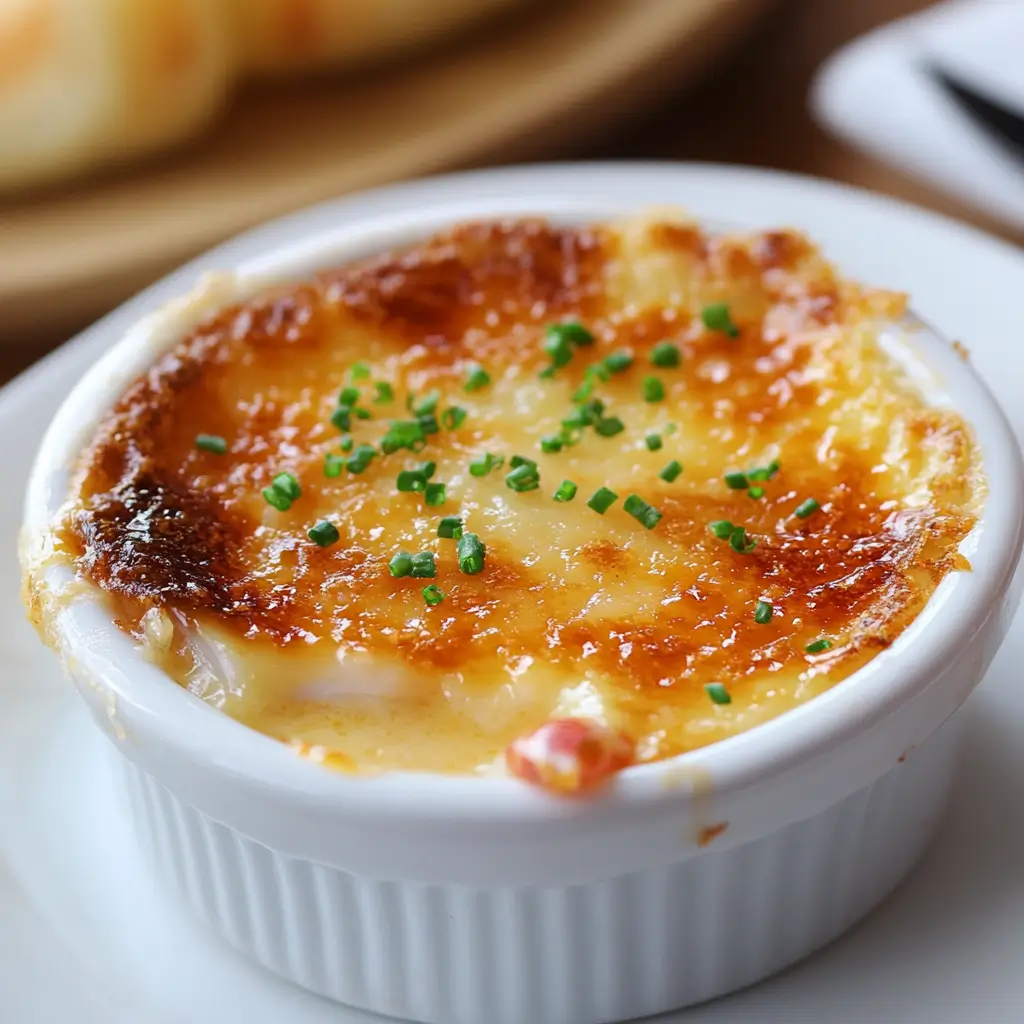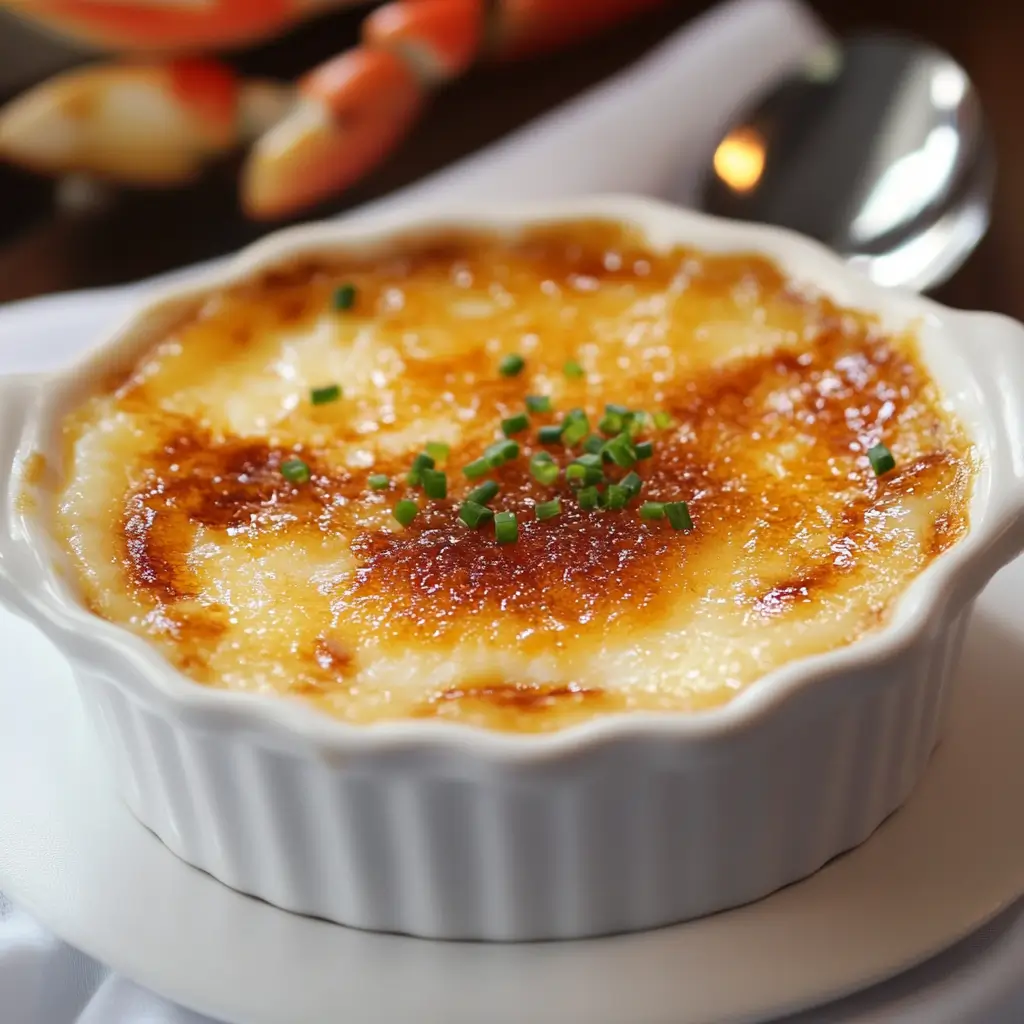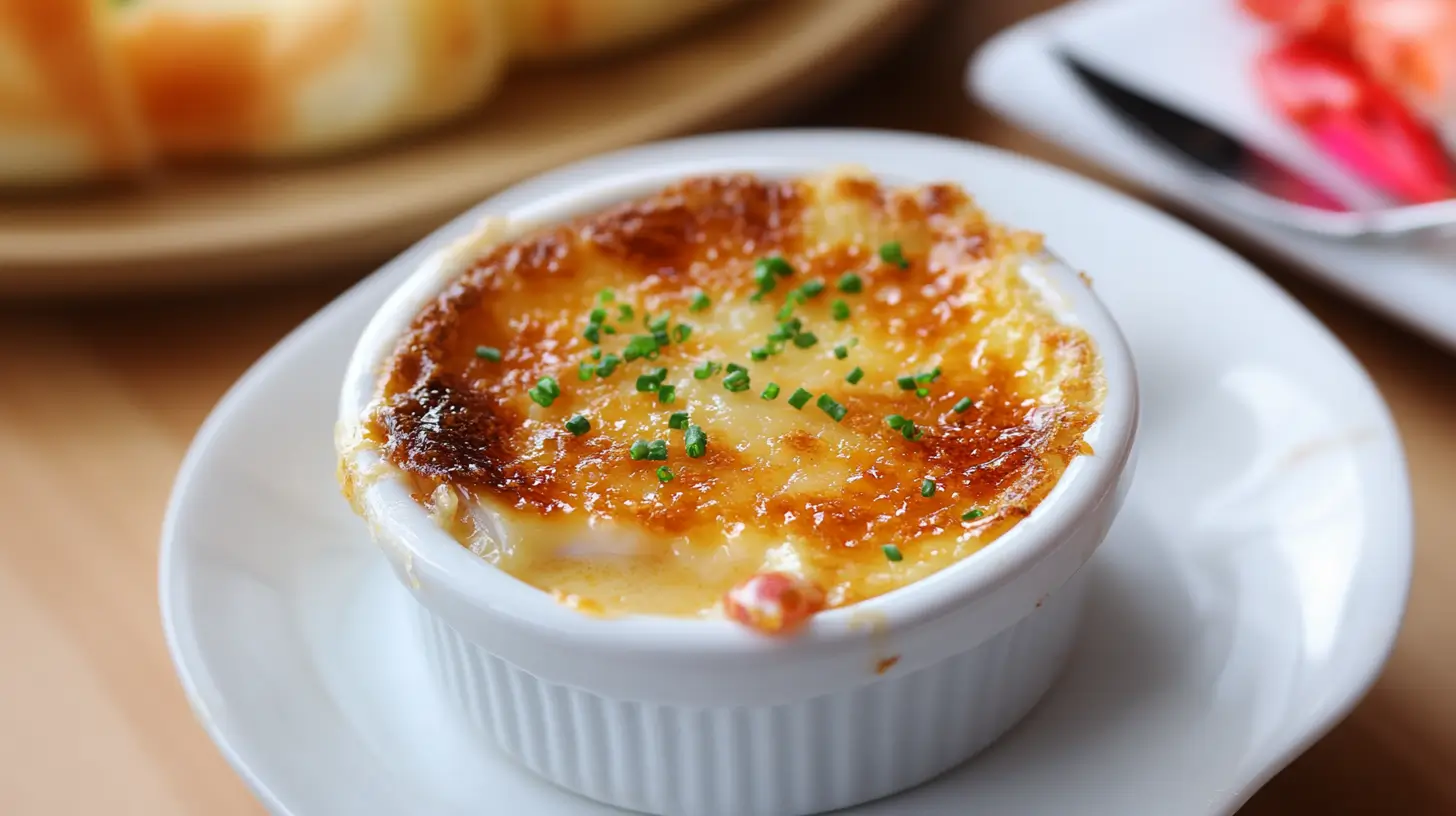Imagine hosting a dinner party and serving up a dish that surprises, delights, and impresses every guest at the table. When you bring out a golden-brown crab brulee, the looks of admiration and the murmurs of excitement are sure to follow. The delicate blend of sweet crab, rich creaminess, and the crispy caramelized sugar topping takes the traditional brulee to an extraordinary new level. This dish isn’t just about flavor; it’s about creating an experience—one that transforms a simple meal into a memorable celebration.
In this article, we’ll dive deep into everything you need to know about the crab brulee recipe, from its ingredients to tips on perfecting the dish and pairing it . Whether you’re a seasoned chef or a curious home cook, this step-by-step guide will walk you through crafting this luxurious dish. Ready to impress your guests? Let’s get started!
Table of Contents
What is Crab Brulee?
At its heart, crab brulee combines two classic culinary ideas: brulee (a dessert with a sugar crust) and savory crab. The dish typically involves a creamy custard base flavored with crab meat, topped with a layer of sugar that gets caramelized into a crispy, golden crust. Think of it as a savory take on the beloved crème brulee, but with the rich, delicate taste of fresh seafood.
Traditionally, brulee is served as a dessert, but this variation takes the creamy, custard-like texture and combines it with the subtle sweetness of crab for a sophisticated entrée. The beauty of this dish lies in the contrast of flavors and textures: the sweetness of the crab and the caramelized topping paired with the rich, velvety custard.
This dish is perfect for special occasions, romantic dinners, or a show-stopping addition to a dinner party. It’s a conversation starter and a guaranteed way to leave your guests impressed.
Key Ingredients for a Perfect Crab Brulee Recipe
Before we jump into the cooking process, let’s take a look at the essential ingredients that make crab brulee a truly unforgettable dish. Quality ingredients are key to achieving that perfect balance of savory and sweet, creamy and crispy. Here’s a list of what you’ll need:
| Ingredient | Quantity |
|---|---|
| Fresh crab meat | 1 cup |
| Heavy cream | 1 cup |
| Egg yolks | 3 |
| Sugar | 1 tbsp |
| Salt | To taste |
| Pepper | To taste |
| Lemon zest | 1 tsp |
| Fresh herbs (optional) | 1 tsp |
Why These Ingredients Matter
- Fresh Crab Meat: The quality of your crab meat will significantly impact the flavor of the dish. Fresh crab adds a sweet, oceanic flavor that’s difficult to replicate with canned or frozen crab. If you can, purchase crab from a local seafood market for the best taste.
- Heavy Cream: The base of the custard requires rich, full-fat cream to achieve the smooth, velvety texture that will balance the savory crab and sweetness from the sugar topping.
- Egg Yolks: These form the custard base and help to thicken the mixture, giving it that rich, creamy texture we all love.
- Sugar: Sugar is key for the brulee’s signature caramelized top. While you’ll only need a small amount, it’s crucial for the final touch.
- Lemon Zest: A subtle citrus element brightens up the richness of the crab and custard, adding depth to the flavor.

Step-by-Step Guide to Making Crab Brulee
Now that we’ve gathered our ingredients, let’s break down the cooking process. Don’t worry if you’ve never made a brulee before—it’s simpler than it seems, and I’ll walk you through it, step-by-step.
1. Prepare Your Ingredients
Before you start, make sure you’ve prepped everything in advance. Preheat your oven to 325°F (165°C) and have your ramekins ready. A water bath will be used to cook the brulee evenly, so ensure you have a baking dish large enough to hold the ramekins with some space between them.
2. Whisk the Custard Base
In a mixing bowl, whisk together the egg yolks, heavy cream, salt, pepper, and sugar. You’re aiming for a smooth, homogenous mixture. Don’t rush this step—whisking the eggs properly helps prevent the custard from separating when it bakes.
3. Add the Crab Meat and Lemon Zest
Gently fold in the crab meat and lemon zest into the egg mixture. Be careful not to overmix, as you don’t want to break up the crab too much. The chunks of crab should remain intact, giving the brulee a nice texture when you dig in.
4. Fill the Ramekins and Bake
Pour the crab mixture evenly into your ramekins. Place the ramekins into a larger baking dish and carefully pour hot water around them, making sure the water level reaches about halfway up the sides of the ramekins. This water bath ensures even cooking and prevents the custard from curdling.
Bake the crab brulee for 30-35 minutes, or until the custard is set but still slightly jiggly in the center. If you have a thermometer, the custard should reach an internal temperature of about 170°F (77°C).
5. Caramelize the Sugar Topping
Once your crab brulees are done baking, it’s time to add the final touch. Sprinkle a thin layer of sugar on top of each ramekin. Using a kitchen torch, caramelize the sugar until it forms a golden, crispy crust. If you don’t have a torch, you can place the ramekins under the broiler for a few minutes, but keep a close eye on them to prevent burning.
6. Serve and Enjoy
Let the brulee cool for a few minutes before serving. Garnish with fresh herbs or a sprig of parsley for a pop of color. Now, it’s time to serve your creation to your guests—and watch as they marvel at your culinary skills.

Common Mistakes to Avoid in Crab Brulee Recipes
Making crab brulee is a straightforward process, but a few small mistakes can affect the final result. Here are some common pitfalls and how to avoid them:
- Overcooking the Crab: Crab meat is delicate, and overcooking it can result in a rubbery texture. Always add the crab to the custard just before baking, and ensure the custard is baked at a low temperature to prevent the crab from being overcooked.
- Using Low-Quality Crab Meat: The flavor of crab is the star of this dish, so it’s worth investing in high-quality, fresh crab. Canned or frozen crab can work in a pinch, but fresh crab will provide the best flavor and texture.
- Burning the Sugar Topping: The caramelized sugar topping is what gives the crab brulee its signature crisp texture. If you’re using a kitchen torch, keep the flame moving to avoid burning one spot. If using a broiler, keep a close eye on the sugar and watch it carefully as it browns.
- Not Using a Water Bath: The water bath is essential for cooking the custard evenly. Without it, the custard may cook too quickly and separate. Always ensure the water level reaches halfway up the sides of your ramekins for the best results.
Variations of the Crab Brulee Recipe
While the classic crab brulee is delicious on its own, there are several ways you can customize the recipe to suit different tastes. Here are a few ideas to elevate the dish further:
- Lobster or Shrimp Brulee: Swap out the crab for lobster or shrimp to create a surf-and-turf brulee. These seafood options will add a slightly different flavor but will still blend beautifully with the creamy custard.
- Spicy Crab Brulee: If you enjoy a bit of heat, add some cayenne pepper, chili flakes, or even a dash of hot sauce to the custard mixture. This will give the dish a nice kick without overpowering the delicate crab flavor.
- Vegan Crab Brulee: For those who prefer a plant-based option, consider using vegan crab meat (such as jackfruit or a plant-based seafood substitute) and coconut cream instead of heavy cream. These swaps can create a dairy-free, vegan-friendly version of the dish.
Crab Brulee for Special Occasions
Crab brulee is more than just a dish; it’s an experience. Whether you’re celebrating an anniversary, hosting a dinner party, or looking to impress a date, this dish brings sophistication and flair to any special occasion. The combination of flavors and textures makes it a conversation starter, and the elegant presentation will surely leave a lasting impression.
Serve it as a main course or pair it with a light salad for a memorable starter. Either way, your guests will be talking about your crab brulee long after the meal is over.
How to Store and Reheat Crab Brulee
If you find yourself with leftovers (though that’s unlikely!), here’s how to store and reheat your crab brulee without losing its flavor and texture:
- Storing: Allow the crab brulee to cool completely before storing it in an airtight container. Keep it in the fridge for up to 2 days.
- Reheating: Gently reheat the brulee in a 300°F (150°C) oven. Be careful not to overcook the custard. If the sugar topping has lost its crispness, use a kitchen torch or broiler to re-caramelize it just before serving.
FAQs:
What is the secret of crème brûlée?
The secret to making a perfect crème brûlée lies in the technique of creating a smooth, velvety custard and achieving the perfect caramelized sugar crust. The custard is made by gently cooking egg yolks, cream (or a cream-milk mix), sugar, and vanilla until it thickens, then baking it in a water bath to prevent overheating. The key is to cook the custard slowly at a low temperature to ensure it’s creamy and smooth, without curdling. The sugar topping is then torched to create that crisp, golden crust—this contrast in textures is what makes crème brûlée so irresistible.
What’s the difference between crème brûlée and custard?
While both crème brûlée and custard are creamy desserts made with egg yolks, sugar, and milk or cream, the main difference lies in their preparation and texture. Crème brûlée is a type of custard, but it is baked in individual ramekins in a water bath and topped with a layer of sugar that is caramelized with a torch, forming a hard, crackable crust. The custard inside remains silky and smooth.
On the other hand, a standard custard (like a custard pie or a pudding) is usually cooked on the stovetop and can have a thicker consistency. Crème brûlée is unique because of its specific preparation method and the contrast of textures between the creamy custard and the crunchy sugar topping.
Can you use milk instead of heavy cream in crème brûlée?
While heavy cream is traditionally used in crème brûlée for its rich and smooth texture, you can substitute milk if you’re looking for a lighter version. However, using milk will result in a less decadent, creamier texture. If you choose to use milk, consider using whole milk for the best results. Alternatively, you could use a combination of milk and cream to balance both richness and lightness.
What does crème brûlée taste like?
Crème brûlée has a rich, velvety texture with a perfectly balanced sweetness. The custard itself is creamy, slightly eggy, and flavored with vanilla (or other flavorings like citrus or coffee). The signature crunchy sugar topping adds a satisfying contrast to the smooth custard. The warm, caramelized sugar gives the dessert a slightly bitter-sweet flavor, which complements the richness of the creamy custard underneath. Overall, it’s a luxurious combination of flavors and textures that many find utterly irresistible.
Conclusion: Mastering the Art of Crab Brulee
Now that you have all the tools you need, it’s time to bring this luxurious dish to life in your own kitchen. With the right ingredients, a little patience, and some creativity, you can create a crab brulee that’s not just a meal but a celebration of flavor and technique. Whether you’re impressing guests at a dinner party or treating yourself to something special, this recipe is bound to become a staple in your culinary repertoire.
So, what are you waiting for? Grab your ingredients, set the table, and get ready to enjoy the delicious flavors of crab brulee. Don’t forget to share your creation with friends and family—they’ll be just as excited as you are to indulge in this exquisite dish!
Ready to Create Your Own Crab Brulee?
We hope this guide has inspired you to try your hand at this decadent dish. Don’t hesitate to experiment with flavors, garnishes, and variations. Share your creations with friends and family, and let us know how your crab brulee turned out in the comments below!

